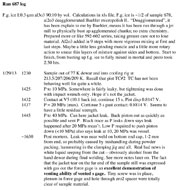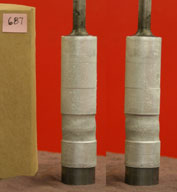| T = 210 K, P = 50 MPa, s = 4 MPa |
step (1) |
| T = 210 K, P = 50 MPa, s = 6 MPa |
step (2) |
| T = 220 K, P = 50 MPa, s = 4 MPa |
step (3) |
| T = 220 K, P = 50 MPa, s = 6 MPa |
step (4) |
| T = 232 K, P = 50 MPa, s = 0.8 MPa |
step (5) |
| T = 232 K, P = 50 MPa, edot ~1.7e-7/s |
step (6) |
| T = 232 K, P = 50 MPa, s = 8 MPa |
step (7) |
Legend: Upper graph of each pair is motor speed V (proportional to edot); lower graph is load (in volts). Translate motor V to edot thus: V1.00 ≈ 6e-6/s ≈ 2%/hr. Load to stress translation for ice687 is roughly 0.25 MPa/mV, with a 5 mV zero offset. Horizontal scale is time. 5000 ≈ 14 hrs. |
| |
|
|
|
|
|
|
| |
|
|
.thb.jpg) |
|
Step (7). Detail of pretty good constant stress control, which it was. |
.thb.jpg) |
|
Thurs 2/7/13 1300 hrs. Step (7) come and gone, e = 0.231. Zoom!! edot averaged ~5.3e-5/s over last 16 minutes; quick calc says n~4.5 wrt step (6). However edot never did steady out, kept rising throughout step. So; extraordinary n, strain softening rather than hardening, gorgeous looking sample (see above) says it wasn't a jacket rupture or buckling instability. Bulge around midriff of sample does indicate significant edot non-uniformity.Obviously complex behavior, and probably due in no small part to low length/diam stubby sample. |
.thb.jpg) |
|
Shortly after previus. End step (6). At this point circumstances change. iMac computer swapped out for another, problem solved, and creep control works again. 2nd prob: stormzilla approaches. Have to end this soon and shut down. |
.thb.jpg) |
|
Thurs 2/7 a.m. Approaching end step (6). e = 0.15. That dip near the beginning of the trace was the result of P dropping to 48 MPa; operator forgot to set P control after earlier LabView crash. |
.thb.jpg) |
|
Weds 2/6 mid day. Start step (6). Computer issues force change to constant udot. Details in run log above. Here s is steadying out near 2.4 MPa at edot ~1.6e-7/s. DLG plot under same conditions shows 100X faster... |
.thb.jpg) |
|
Detail of that last dip in step (5), indicates dip is real and probably result of creep control not being able to follow well at such slow edot. |
.thb.jpg) |
|
Weds a.m. 2/6/13. End step (5). e = 0.139 still. edot for most of this step was not higher than 4e-9/s, can hardly distinguish from 0/s. |
 trouble.thb.jpg) |
|
Tues p.m. Start step (5) |
.thb.jpg) |
|
Tues a.m. 2/5/13. End step (4), e = 0.139. |
.thb.jpg) |
|
Mid step (4). |
.thb.jpg) |
|
Mon 2/4/13. Skillful start to step (4) |
.thb.jpg) |
|
Late Sun 2/3/13. End step (3), e = 0.070. Over the last ~2000 pts (~4 hrs) there was actually slight strain softening. Again (see early 2/2/13 note) it may be difficult to separate this from noise. |
.thb.jpg) |
|
Mid step (3). |
.thb.jpg) |
|
Sun 2/3/13. Very start of step (3). Note the ~45 min slow run in of the piston to contact, remote operator just being conservative. |
.thb.jpg) |
|
End step (2), e = 0.053. First blush look says strength here not that different from that of run 590, first in this series ~a decade ago, and which we've talked about as sort of a throwaway.
Emergency LN arrives ~ 3 hrs after end of step. Experiment is saved. |
.thb.jpg) |
|
early Sat 2/2/13. Step (2) continues. Yellow sticky in lower r.h. corner shows edot calcs; values indicate slight strain hardening continues. Note however this can't be distinguished at this point from an incorrect load correction based on an estimate of starting sample length, L0, that is 6% too long (for n=3)*. True L0 won't be known until the end of the experiment, and at that point we can figure out if the e hardening is real.
*[(3.0/2.5)^0.33 = 1.06] |
.thb.jpg) |
|
Step (2) start.
[meanwhile: scrambling to avert LN crisis: forgot to order some for the weekend] |
.thb.jpg) |
|
Fri 2/1/13. Step (1) to end, e = 0.025. Final edot is somewhere near 0.8e-7/s; not clear that it isn't still strain hardening. |
.thb.jpg) |
|
Step (1). Looks like it strain hardened to almost edot=0 |
.thb.jpg) |
|
Thurs 1/31/13. Step (1) start |
| |
|
|
.thb.jpg)
.thb.jpg)
.thb.jpg)
.thb.jpg)
.thb.jpg)
.thb.jpg)
.thb.jpg)
 trouble.thb.jpg)
.thb.jpg)
.thb.jpg)
.thb.jpg)
.thb.jpg)
.thb.jpg)
.thb.jpg)
.thb.jpg)
.thb.jpg)
.thb.jpg)
.thb.jpg)
.thb.jpg)
.thb.jpg)
 Run log
Run log working plot.thb.jpg) working plot
working plot